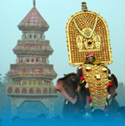Munnar
Munnar is a town located in the southern state of Kerala in India. The name is most often used to refer to the whole tourist area, of which the town forms a part. The etymology of Muannar is believed to be derived from the Malayalam words Muunu (three) and aaru (river), referring to the town's strategic location at the confluence of the mountain streams of Muthirappuzha, Chanduvarai and Kundala. Situated at nearly 1,600 to 1,800 meters above sea level, the region is surrounded by vast jungles and remains wet and cold during most of the year. Nearby is the Mattupetty Dam.The people of Munnar share in the culture and traditions of Kerala. Tamil immigrants from the neighbouring state of Tamil Nadu also figure significantly in the population.
Wildlife
A plethora of flora and fauna is found in Munnar. This includes the world renowned "Neelakurunji" Which only flowers once in 12 years! which attracts more tourists during the period. The flower will only last a few days. This flower is believed to grow only in the Hills of Munnar. Also there are many varieties of animal species and wildlife like Neelagiri Thar which is a variety of mountain deer inhabiting the hills of Munnar.
This article is licensed under the GNU Free Documentation License. It uses material from the Wikipedia and numerous other sources that provide freedom to copy and redistribute content, with or without modifying it, either commercially or noncommercially. |







